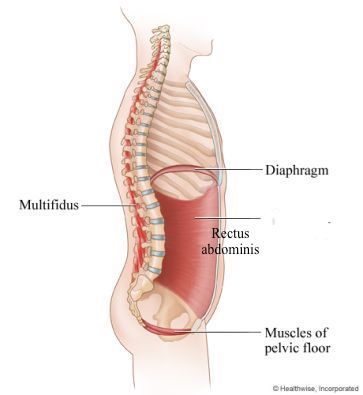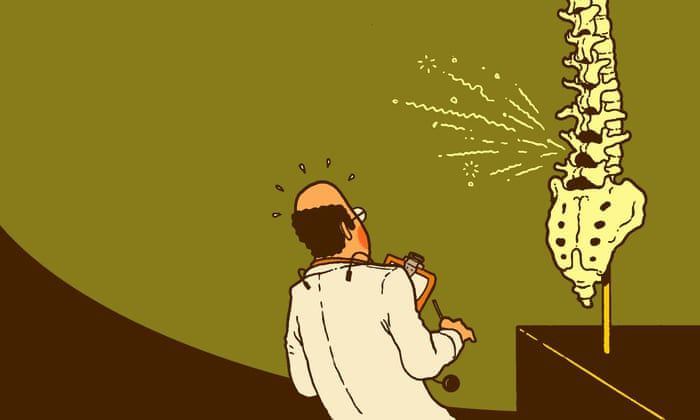Six Myths About Back Pain! Your lower back is stronger than you think! "two"
I wonder if last week's article has added to your understanding of low back pain? If you haven't read it, please click here or the link below, maybe it can change your established impression of posture, image detection (such as MRI, X-RAY)! Without further ado, let's talk about myths about low back pain today!
"Related Article": Six Myths About Low Back Pain! Your lower back is stronger than you think! "one"
Myth 1: "Too weak" core muscles lead to "unstable" lower back and lower back pain
First of all, "Core" is broadly defined as the three-dimensional space near the lower thoracic and lumbar vertebrae. It can be imagined as a three-dimensional space composed of the diaphragm (Diaphragm), the multifidus (Multifidus), the rectus abdominis (Rectus Abdominis) and the pelvic floor muscles (Pelvic) Floor Muscles) a three-dimensional space composed of four walls. The core muscles refer to the various groups of muscles in this three-dimensional space.

Just Google "low back pain", "low back pain" and other key words, and it is not difficult to see a lot of "health websites" that attribute low back pain to weak core muscles, resulting in a lack of stability in the lower back, and claim that training core muscles can help. Helps reduce and prevent low back pain. But is there any scientific evidence for this claim? Various studies point out:
✔The strength of core muscles cannot predict clinical outcomes, including pain level, recovery time and speed, etc. That is to say, in the case of reducing low back pain, improving muscle strength is not the main consideration. (Mannion et al., 2012).
✔ Weak core muscles do not cause low back pain. Conversely, where patients are told that their lower backs are "weak," "unsteady," "displaced," etc., there is a risk of anxiety, avoidance behavior, and pain catastrophism about pain symptoms and the recovery process (Pain Catastrophizing). These negative thoughts are more strongly associated with long-term low back pain than actual structural damage or muscle strength (O'Sullivan et al., 2019). In fact, the human spine is very, very, very strong (it is too important, so it has to be repeated three times). Taking the cervical spine as an example, it takes about 3000 Newtons of force to cause a fracture. In concrete terms, this is roughly equivalent to a driving 30 kilometers per hour, close to the impact of a 250 kg car. The so-called "shift" is actually mostly due to the visual illusion caused by muscle tension. The claims of "unsteadiness" and "fatigue" causing low back pain are groundless and lack scientific evidence.
✔ Core muscle training is no more effective than other exercises in relieving low back pain. In fact, most sports, such as swimming, Pilates, cycling, etc., can help relieve low back pain to some extent . The reason behind it is not yet clear, but it is currently inferred that exercise helps to increase the secretion of serotonin and dopamine. These two hormones not only relieve anxiety, but are also natural pain relievers produced by the body to help reduce pain. Conversely, core muscle training tends to tighten the abdominal muscles, compress the spine and adjacent tissues, and increase pain (Saragiotto et al., 2016). Therefore, when choosing rehabilitation exercises, the patient's preferences should be taken as the basis, as long as some movements and postures that may cause pain are avoided!
Myth 2: Low back pain represents structural damage, stop all activities and rest immediately

"I don't think it's appropriate for you to play basketball anymore", "If you continue to play basketball, you may spend the rest of your life in a wheelchair", "You should stop all training, take three to six months off, and see Has the low back pain improved?” Can you imagine that I have heard these words with my own ears? At that time, my long-term back problems limited my basketball training from time to time. After consulting more than ten orthopaedic surgeons, physical therapists, and traditional Chinese medicine practitioners, most of them came to the above conclusions. I also sincerely believe that many chronic low back pain sufferers have heard the same advice. However, is this consistent with the research results?
✔Low back pain is not the same as structural damage. Most low back pain results from the muscles and tissues near the spine becoming "sensitive", that is, the nociceptors responsible for pain perception become easily stimulated and the brain produces pain sensations. Interestingly, this phenomenon was more strongly associated with changes in physical activity, stress and mood (O'Sullivan et al., 2019). In other words, if the patient is advised to rest completely because of low back pain, and if the amount of exercise or workload is drastically changed, it will put the cart before the horse in the rehabilitation process, and will be harmful and not beneficial. Conversely, as mentioned above, encouraging patients to maintain physical activity while avoiding painful movements and postures can help ease back pain and the recovery process.
That's it for today's content. Stay tuned for more low back pain myths to be shared with you next Wednesday!
If you think my content helps you learn more about scientifically proven rehabilitation and exercise, please share it with your friends and family, and follow me on Facebook and Instagram!
Facebook: https://www.facebook.com/H2PerformanceLab
Instagram: www.instagram.com/h2performancelab
Matters: https://matters.news/@h2performance
Or join Likecoin and become a Liker! Press the Appreciation button below! Each of your free likes and supports will bring me a meager income as the cost and motivation of operating the platform!
https://liker.land/henryhung/civic
Like my work? Don't forget to support and clap, let me know that you are with me on the road of creation. Keep this enthusiasm together!

- Author
- More